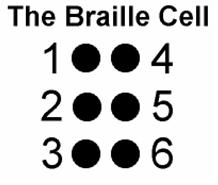The Braille Alphabet Delivers Literacy and Independence
Braille code is a writing system which enables blind and partially sighted people to read and write through touch. Braille consists of patterns of raised dots arranged in cells of up to six dots in a 3×2 configuration. Each cell represents a braille letter, numeral or punctuation mark. Some frequently used words and letter combinations also have their own single cell patterns.
 Braille Code Versions:
Braille Code Versions:
- Grade 1: consists of the 26 standard letters of the alphabet and punctuation. It’s mainly used by people who just started reading braille.
- Grade 2: consists of the 26 standard letters of the alphabet, punctuation and contractions. The contractions are employed to save space because a braille page cannot fit as much text as a standard printed page. Books, signs in public places, menus, and most other braille materials are written in Grade 2 braille.
- Grade 3: is used only in personal letters, diaries, and notes. It is a kind of shorthand, with entire words shortened to a few letters.
The braille alphabet was invented by Louis Braille (1809-1852), a French teacher who worked with students who where blind. Louis was blind as well and is widely known as the “father of braille”. Check out the history of braille page for more details on Louis Braille and his creation of braille code.
Braille has been adapted to many different languages and is also used for musical and mathematical notation. Contact Braille Works today to learn how we can help with all of your braille and alternative format needs.
 Braille Code Versions:
Braille Code Versions:






























